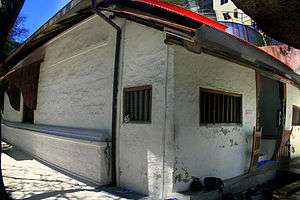Dhovemi of the Maldives
Dhovemi Kalaminja Siri Thiribuvana-aadiththa Maha Radun (Dhivehi: ދޮވެމި ކަލަމިންޖާ ސިރީ ބަވަނަ އާދީއްތަ މަހާ ރަދުން) or Donei Kalaminjaa (Dhivehi: ދޮނެއި ކަލަމިންޖާ) was the second king of the Maldives from 1141 to 1166 or 1176 according to the Raadhavalhi and the Loamaafaanu copper plate writings (two sources from which the early history of the Maldives is studied). The Taarikh chronicles. however calls this king Sultan Muhammad ibn Abdullah which is probably the Muslim name of the king after his conversion to Islam in the 12th year of his reign. Later on the title of Dharumavantha (Dharumas) Rasgefaanu or 'the benevolent king' was bestowed upon him. He is also known as the first ruler of the Theemuge Dynastry (not considering King Koimala of the Lunar Dynastry). This name was derived from his house's name, Theemuge, some sourced refer to the royal house as the Maalei Dharikolhu. Though it was being called Theemuge Darikolhu they were descendents of the Buddhist Kings of the Lunar Dynastry or Soma Vansa.

Dhovemi was the son of Henevi Maavaa Kilage (Dhivehi: ހެނެވި މާވާ ކިލެގެ) the sister of the first King Koimala of all the Maldives. He ruled for 25 years, 12 years as a Buddhist and 13 years after his conversion to Islam. The conversion of Dhovemi,[1] and later the whole Maldivian Kingdom to Islam was accredited by Ibn Batuta, after visiting the Kingdom and staying there for some time, to Abu al Barakat al-Barbari (a Berber from the Maghreb). Later sources claim that a Persian from the Tabriz, called Yusuf Tabrizi was responsible for the conversion of the Maldivian Kingdom to Islam in the year 1153. The newly converted king became the first sultan of the Maldives. The governace of the country is said to have been carried out by the king as advised by Yusuf Tabrizi. King Dhovemi sent emissaries to the different atolls to convert all the inhabitants without exception to the Muslim faith. The king himself sailed to the island of Nilandhoo in North Nilande Atoll and converted them to Islam. He is also said to have built a mosque there. The conversion of the whole country is said to have taken place on the 2nd day of Rabi'-ul-Akhir 548 AH (1153 AD) on the 17th year of Al-Muqtafi, the Caliph of Baghdad, and since then the Maldives has been a predominantly Islamic country. By the order of the king as his brother Siri Kalo the first Friday mosuque of Malé was built by Al-Wazir Shanivirazaa. The Dharumavantha Miskyii—the oldest mosque in Malé—is said to have been built by King Dhovemi.
Sultan Dhovemi was the first to enforce Islamic law. All traces of idolatry were effaced during this period of major reformation and mosques were built on many of the inhabited islands. The sultan is said to have been just, impartial, pious, secular and was beloved by his subjects for his wisdom, kindliness and generosity.
The death of the Sultan is not recorded, but he is said to have disappeared in 1166 on a voyage to Mecca to perform the Hajj. The Taarikh writes as revived from the Isdhoo loamaafanu:
"(he said) next Friday a ship will arrive, whereon I shall sail for Makkah. The day named verily a vessel anchored at Malé. The Sultan, having performed the Jumu'ah (Friday-noon prayers) at the mosque, hurried to the seashore and embarked in the vessel without attendants or provisions. Forwith the ship passed from sight as suddenly as lightning (and he was not heard from thence)"
On the disappearance of his uncle, Muthey Kalaminja took over the throne of the Maldives and ruled as the sultan from 1166 according to the Raadhavalhi. The Isdhoo (1195–1196) and Dhan'bidhoo (1196–1197) Loamaafaanus (copper plates) give the date as 1176.
References
| Regnal titles | ||
|---|---|---|
| Preceded by Koimala |
King of the Maldives 1141–1153 |
Succeeded by — |
| Preceded by — |
Sultan of the Maldives 1153–1166 |
Succeeded by Muthey |